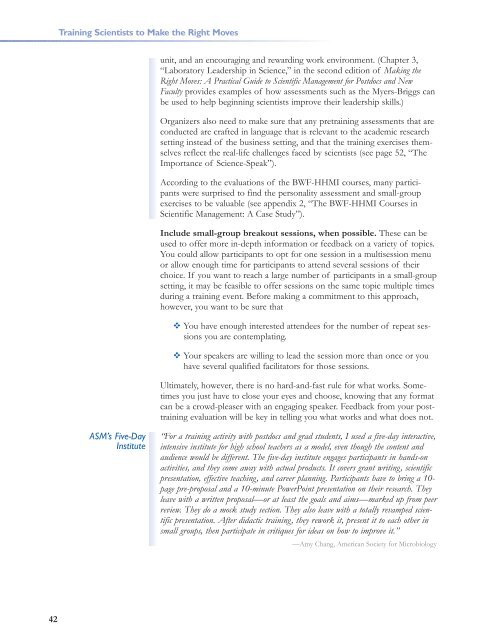Training Scientists to Make the Right Moves - Howard Hughes ...
Training Scientists to Make the Right Moves - Howard Hughes ...
Training Scientists to Make the Right Moves - Howard Hughes ...
Create successful ePaper yourself
Turn your PDF publications into a flip-book with our unique Google optimized e-Paper software.
<strong>Training</strong> <strong>Scientists</strong> <strong>to</strong> <strong>Make</strong> <strong>the</strong> <strong>Right</strong> <strong>Moves</strong><br />
unit, and an encouraging and rewarding work environment. (Chapter 3,<br />
“Labora<strong>to</strong>ry Leadership in Science,” in <strong>the</strong> second edition of Making <strong>the</strong><br />
<strong>Right</strong> <strong>Moves</strong>: A Practical Guide <strong>to</strong> Scientific Management for Postdocs and New<br />
Faculty provides examples of how assessments such as <strong>the</strong> Myers-Briggs can<br />
be used <strong>to</strong> help beginning scientists improve <strong>the</strong>ir leadership skills.)<br />
Organizers also need <strong>to</strong> make sure that any pretraining assessments that are<br />
conducted are crafted in language that is relevant <strong>to</strong> <strong>the</strong> academic research<br />
setting instead of <strong>the</strong> business setting, and that <strong>the</strong> training exercises <strong>the</strong>mselves<br />
reflect <strong>the</strong> real-life challenges faced by scientists (see page 52, “The<br />
Importance of Science-Speak”).<br />
According <strong>to</strong> <strong>the</strong> evaluations of <strong>the</strong> BWF-HHMI courses, many participants<br />
were surprised <strong>to</strong> find <strong>the</strong> personality assessment and small-group<br />
exercises <strong>to</strong> be valuable (see appendix 2, “The BWF-HHMI Courses in<br />
Scientific Management: A Case Study”).<br />
Include small-group breakout sessions, when possible. These can be<br />
used <strong>to</strong> offer more in-depth information or feedback on a variety of <strong>to</strong>pics.<br />
You could allow participants <strong>to</strong> opt for one session in a multisession menu<br />
or allow enough time for participants <strong>to</strong> attend several sessions of <strong>the</strong>ir<br />
choice. If you want <strong>to</strong> reach a large number of participants in a small-group<br />
setting, it may be feasible <strong>to</strong> offer sessions on <strong>the</strong> same <strong>to</strong>pic multiple times<br />
during a training event. Before making a commitment <strong>to</strong> this approach,<br />
however, you want <strong>to</strong> be sure that<br />
You have enough interested attendees for <strong>the</strong> number of repeat sessions<br />
you are contemplating.<br />
Your speakers are willing <strong>to</strong> lead <strong>the</strong> session more than once or you<br />
have several qualified facilita<strong>to</strong>rs for those sessions.<br />
Ultimately, however, <strong>the</strong>re is no hard-and-fast rule for what works. Sometimes<br />
you just have <strong>to</strong> close your eyes and choose, knowing that any format<br />
can be a crowd-pleaser with an engaging speaker. Feedback from your posttraining<br />
evaluation will be key in telling you what works and what does not.<br />
ASM’s Five-Day<br />
Institute<br />
“For a training activity with postdocs and grad students, I used a five-day interactive,<br />
intensive institute for high school teachers as a model, even though <strong>the</strong> content and<br />
audience would be different. The five-day institute engages participants in hands-on<br />
activities, and <strong>the</strong>y come away with actual products. It covers grant writing, scientific<br />
presentation, effective teaching, and career planning. Participants have <strong>to</strong> bring a 10-<br />
page pre-proposal and a 10-minute PowerPoint presentation on <strong>the</strong>ir research. They<br />
leave with a written proposal—or at least <strong>the</strong> goals and aims—marked up from peer<br />
review. They do a mock study section. They also leave with a <strong>to</strong>tally revamped scientific<br />
presentation. After didactic training, <strong>the</strong>y rework it, present it <strong>to</strong> each o<strong>the</strong>r in<br />
small groups, <strong>the</strong>n participate in critiques for ideas on how <strong>to</strong> improve it.”<br />
—Amy Chang, American Society for Microbiology<br />
42
















